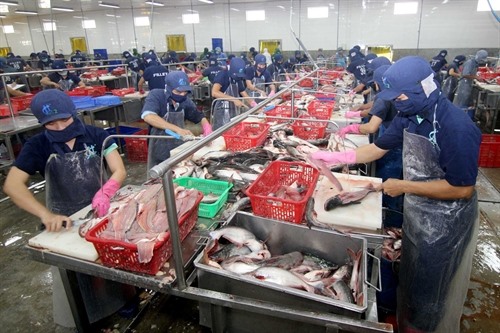 Economy
Economy

Tra (pangasius) fish prices skyrocketed last month, reaching a 10-year high, but experts warn that export of this seafood product could be unstable this year.
 |
| Tra fish being processed for export at Hùng Cá Company Ltd in southern Đồng Tháp Province’s Thanh Bình District. — VNA Photo Vũ Sinh |
HÀ NỘI — Tra (pangasius) fish prices skyrocketed last month, reaching a 10-year high, but experts warn that export of this seafood product could be unstable this year.
They said measures should be taken to restore declining imports to major markets like the United States and Europe, counter misinformation about the local seafood industry, and create a national brand with quality products.
In the Cửu Long (Mekong) Delta provinces, tra fish prices surged by VNĐ4,000-7,000 (20-27 US cent) per kilo over last year to VNĐ24,000-29,000. At these prices, it is estimated that farmers can earn profits of VNĐ1.5-1.7 million per tonne.
Meanwhile, the prices of tra fish breeds climbed to VNĐ50,000-60,000 per kilo in late April and early May, VNĐ20,000 higher than early April, a threefold year-on-year increase.
According to the Việt Nam Association of Seafood Exporters and Producers (VASEP), tra fish prices in the Asian market averaged $2.3 per kg in January and rise $2.7 per kg in February, up 17.3 per cent. By April, the prices rose to $2.8-3.00 per kg, up 30.4 per cent compared with the beginning of the year.
Sustained surge
VASEP general secretary Trương Đình Hoè told Thời báo Kinh tế Việt Nam (Việt Nam Economic Times) that tra fish prices had started to rise a few months prior to the Lunar New Year festival that fell in January, and reached its peak in April. This was the longest period ever that prices kept increasing, and the trend might continue until the end of 2017, Hoè said.
He attributed the surge in purchasing prices to a lack of supply in the market as a result of households abandoning tra fish farming after many consecutive years of losses.
Export orders for tra fish in early 2017 rose 10 per cent year-on-year, while tra fish bred for export processing in 2016 fell, Hoè added.
In previous years, the United States and EU were Việt Nam’s largest export markets for tra fish, but this has declined in recent years. In Q1 this year, export value of tra fish to the United States was just $61 million, down 24.3 per cent year-on-year, and corresponding figures for the EU and Southeast Asia also dropped sharply, by 21.5 and 10 per cent, respectively.
Hòe said anti-dumping tariffs were mainly to blame for the decline. In the United States, for instance, Vietnamese exporters had to pay tariffs of $3 per kilo, discouraging them from developing tra fish for export, Hoè said, adding that recent incorrect news broadcasts by overseas media had also hurt exporters.
However, tra fish exports to China have shot up since the beginning of this year, surging by 50 per cent over the same period last year. VASEP estimates that China will overtake the US this year as the largest importer of Vietnamese tra fish, with imports of approximately $400 million.
This sudden growth poses many risks, Hoè cautioned, without elaborating.
National seafood brand
He said it is crucial that Việt Nam regains its lost market share in the EU and United States and promotes the image of tra fish bred in the country.
Towards this, the Ministry of Agriculture and Rural Development (MARD), in collaboration with VASEP, has launched a campaign to boost the brand of Việt Nam’s tra fish.
VASEP has suggested that the agriculture ministry re-activate the Market Development Fund established in 2002 by the former Ministry of Fisheries.
The association has also called for a focus on high-quality tra fish products that would enable the creation of a national brand.
For this, large tra fish processing firms should collaborate with multinational corporations to enhance product quality, it said.
It has advised exporters to strengthen co-operation with management agencies in importing countries to ensure strict quality control in labeling, especially for the European market.
The association stressed the need to negotiate with some countries in central America that are imposing excessive anti-dumping measures on tra fish.
At the Seafood Expo Global held in Brussels, Belgium, from April 25-27, VASEP introduced several Vietnamese seafood products including tra fish. At this event, VASEP and MARD organised a press conference to provide clear information about Việt Nam’s tra fish processing and exports to European partners.
The event was held in the context of a tra fish crisis in Spain and the Carrefour supermarket chain stopping sales of Vietnamese tra fish.
Hòe said the press conference aimed to provide correct information about Việt Nam’s seafood industry and target increasing exports to Europe. — VNS




